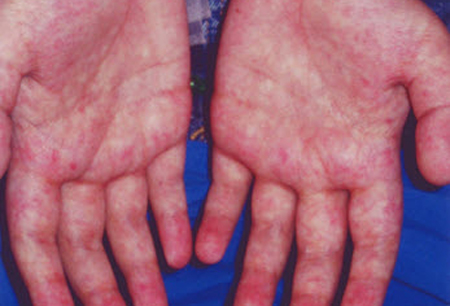Summary
Definition
History and exam
Key diagnostic factors
- allogeneic hematopoietic cell transplantation (HCT) recipient
- human leukocyte antigen (HLA) mismatch and unrelated donor
- parous female donor
- female donor with male recipient
- new-onset painful mouth sores
- hyperpigmented skin lesions
- diffuse maculopapular rash
- genital signs and symptoms
- nausea, vomiting, abdominal pain, profuse diarrhea, and anorexia
Other diagnostic factors
- joint stiffness or tightness
- day +21 to day +25 after HCT
- cyclophosphamide + total body irradiation (Cy/TBI) conditioning regimen
- peripheral blood stem cell transplant
- dry, gritty, and painful eyes
- jaundice
- hepatomegaly
- scleroderma
Risk factors
- HLA mismatch and unrelated donor
- prior acute GVHD
- recipient or donor in older age group
- female donor with male recipient
- parous female donor
- type and stage of underlying malignant condition
- high-intensity conditioning radiation regimen
- peripheral blood stem cell transplant
- donor lymphocyte infusion (DLI)
- absent or suboptimal GVHD prophylaxis
- white or black race
- cytomegalovirus (CMV) seropositive
- splenectomy
- low performance status score
- low socioeconomic status
Diagnostic tests
1st tests to order
- CBC
- serum electrolytes
- liver functions tests
- urinalysis
- urine culture
- blood culture
- stool culture
- viral polymerase chain reaction (PCR) studies
Tests to consider
- CT abdomen
- Doppler ultrasound of the liver
- tissue biopsy (skin, gastrointestinal [GI] tract, liver, or lung)
- pulmonary function tests
- high-resolution CT chest
- bronchoalveolar lavage (BAL) and culture
- echocardiogram
- barium swallow or upper gastrointestinal endoscopy
- 18F-fluorodeoxyglucose positron emission tomography (FDG-PET) scan
Treatment algorithm
Contributors
Authors
Sung Won Choi, MD, MS

Professor
Department of Pediatrics
Division of Pediatric Hematology Oncology/Blood and Marrow Transplantation
University of Michigan
Ann Arbor
MI
Disclosures
SWC is an author of a number of references cited in this topic.
Lyndsey Runaas, MD

Assistant Professor, Hematology and Oncology
Division of Hematology/Oncology
Medical College of Wisconsin
Milwaukee
WI
Disclosures
LR declares that she has no competing interests.
Acknowledgements
Dr Sung Choi and Dr Lyndsey Runaas would like to gratefully acknowledge Dr Pavan Reddy, a previous contributor to this topic.
Disclosures
PR is an author of a number of references cited in this topic.
Peer reviewers
Corey Cutler, MD, MPH, FRCPC
Associate Professor of Medicine
Harvard Medical School
Dana-Farber Cancer Institute
Boston
MA
Disclosures
CC declares that he has no competing interests.
Waseem Qasim, BMedSci (Hons), MBBS, MRCP (UK), MRCPCH, PhD
Senior Lecturer
Institute of Child Health
Consultant in Paediatric Immunology & Bone Marrow Transplantation
Great Ormond Street Hospital
London
UK
Disclosures
WQ declares that he has no competing interests.
Use of this content is subject to our disclaimer
